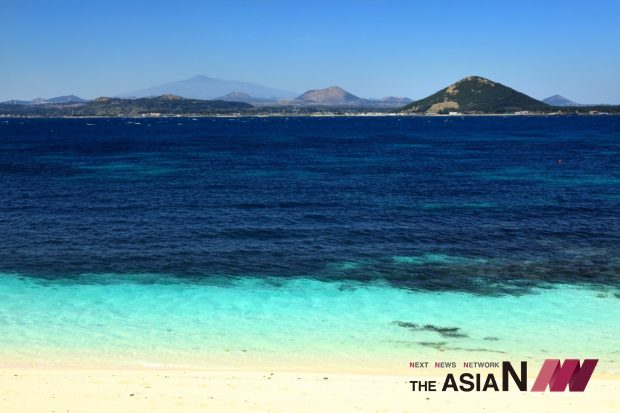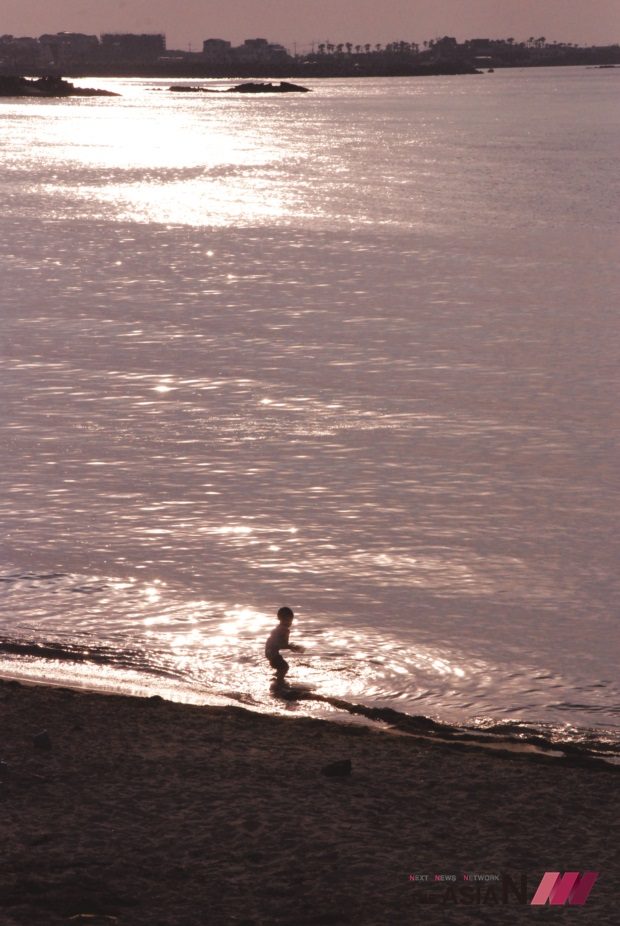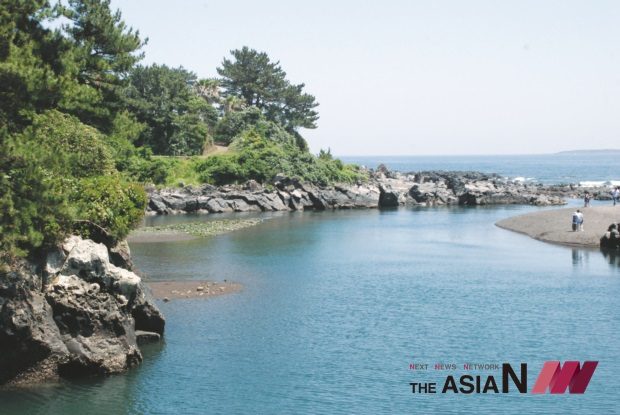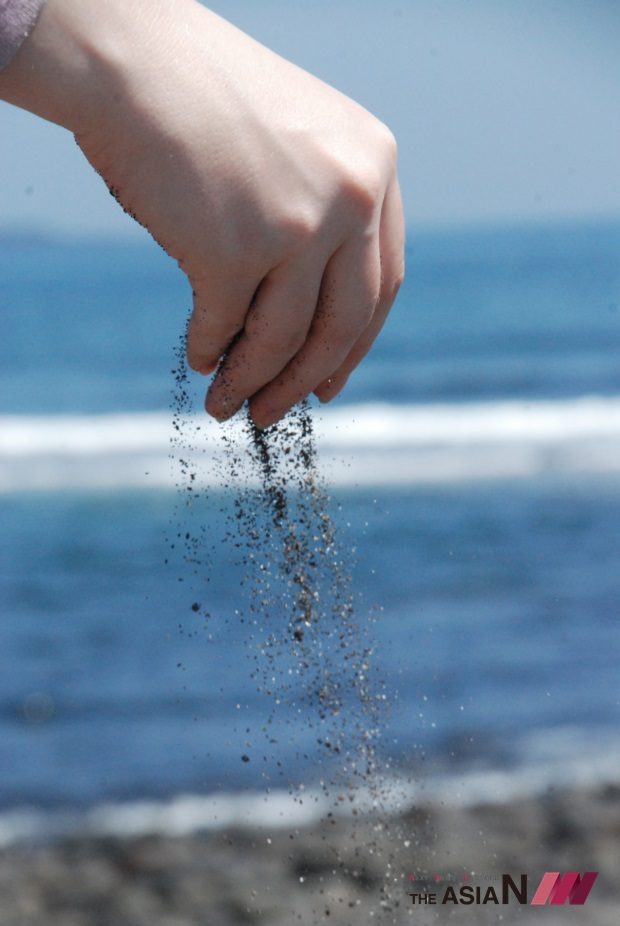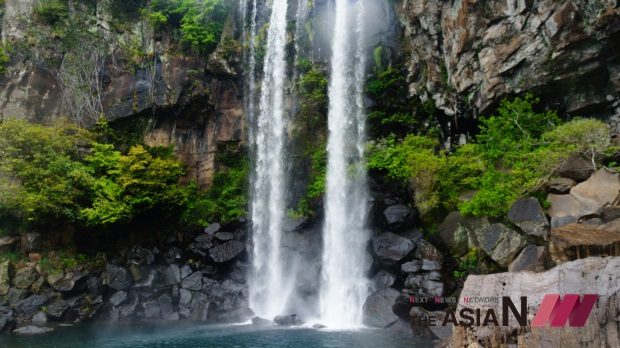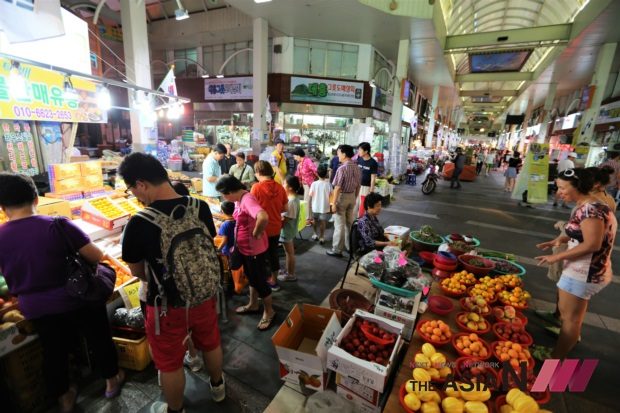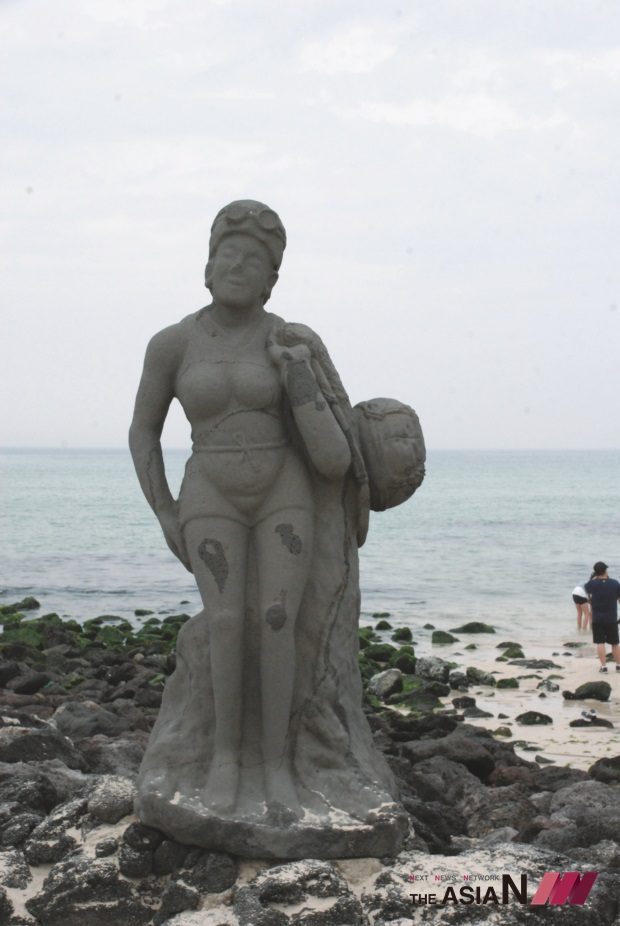Jeju Guide for Backpackers: Rocks, Wind and Haenyo
Jeju is, by far, Korea’s most popular tourist destination. The Island had always been crowded with Chinese tourists, but lately, as tensions arose between China and Korea over THAAD, few Chinese have chosen to vacation in Jeju. Instead, travelers from Korea, Southeast Asia, America, and Europe have been increasing each year. Tourist organizations, seeing this shift, have been refocusing their efforts to the changing demographic. This being the case, what do foreigners actually think of Jeju? Italian reporter Alessandra Bonanomi describes her 3-day trip to Jeju Island as a backpacker. – Editor’s note
Jeju-do, Korea’s largest island, has long been the country’s favorite domestic holiday destination thanks to its beautiful beaches, lush countryside, and seaside hotels designed for rest and relaxation. Also thanks to caves, museums, markets and amazing food, the island is full of tourists. It is well known for its natural wonders, including waterfalls, white sand beaches, and a dormant volcano–South Korea´s highest mountain–at the center of the island. Jeju-do, located 64 kilometers south of the Korean Peninsula, is full of parks, gardens, and festivals. The capital of Jeju Island is Jeju city.
Three main components are associated with Jeju: rocks, wind, and haenyeo, the female divers of Jeju-do.
The Jeju people of old made use of rocks just lying about and made walls that would block strong winds. Dolharubang which is a symbol of Jeju is a stone statue made from the basalt rocks. The second element, wind, invites people to surf. In fact, surfers on the waves is quite a common sight Jeju-do. The last component, haenyeo, is probably the most interesting aspect. The word haenyeo directly translated is “sea woman” and refers to female occupational divers who fish for seafood and seaweed with no exterior breathing apparatus.
Divided into three groups according to their experience (upper class, middle class and lower class), haenyeo learn to control their breathing underwater.
Since 1970, the government has been trying to support the diving women by providing wetsuits and subsidizing medical insurances, but the number of haenyeo continues to decrease with each year. The tools the women use can also be divided into three categories: hand tools (knife, small hoe, and sickle), collection equipment (fisihng net, buoy), and diving-wear. When diving, haenyeo let out a curious sound, sumbi-sori, which is a unique breathing technique and a sign of acknowledging each other’s presence. In 2016, haenyeo were listed as an invaluable cultural heritage of humanity by UNESCO for their contribution to the advancement of women’s status in the community, promoting environmental sustainability with their eco-friendly fishing methods, and for their involvement in the management of fishing practices.
Of course besides these, Jeju overflows with great food and beautiful sites such as Hamdeok Beach, Soesokkak Estuary, and Jeongbang Falls.
As a foreign backpacker, in the following pages I will relate to readers the positive and negative aspects of my three-day trip to Jeju Island.
Day 1
Udo Island
From Jeju Intercity Bus Terminal, take Bus No. 701 or 710 to Seongsanhang Port Bus Stop (travel time approx. 1hr 30 min.). Walk to Seongsanhang Port Passenger Ferry Terminal (approx. 12 min). Board ferry bound for Udo Island (travel time 15 min.). Ferry Price: 6,000 won round trip.
In the morning I visited Udo Maritime Park, a small island situated off the eastern coast of Jeju Island. Udo presented itself as a green (grass) and black (rocks) place surrounded by the ocean. Once the ferry was docked, people first, and then cars, got off the boat.
The small info point is the first building people see once arrived on the island. Plenty of stations at the ports rent bicycles, scooters, and quad bikes. An international driver’s license is required to rent motorized vehicles. The easiest option is to ride an island tour bus, which makes four slightly hurried stops at Udo-bong, Dongangyeonggul Cave, Hagosudong beach, and Seobin White Sand Beach. But despite being able to ride the bus or a scooter, I decided to walk. Since the entire route takes 5 hours (by foot), I decided to spend two hours on the island in order to visit some lighthouses and to hike around Seongsan. As I was walking along the island, “Gangnam Style” kept the attention of tourists: in fact, some horses were ready for horseback riding on the Island. Typical dishes found on the island are Hallasan fried rice, peanut and tangerine ice-cream, and sashimi.
Hamdeok Beach
From Jeju International Airport, take Bus No. 38 to Hamdeok Beach.
As the sun began to set, I made my way to Hamdeok Beach. Located 14 km east of Jeju City, Hamdeok Beach is famous for its clean and shallow waters. It hosts three separate beaches, a large open park surrounded by cafés, walking paths, and countless tents housing families during the summer months. There are also many restaurants in this area. One of the best foods to try in this area is haemul ddukbaegi or seafood pot. In this relaxing atmosphere, couples and children relax in front of the ocean. It also common to see horses grazing in the grass.
Day 2
Seogwipo
The Airport Limousine (route No. 600) bus runs from Jeju International Airport to Seogwipo every 15 to 20 minutes. Travel time takes about an hour and 20 minutes. Cost is 5$ per person. The bus makes around 10 stops, which includes all the five-star hotels in the Jungmun Resort Area. The final stop is the Korean Airlines Hotel (KAL Hotel) in Downtown Seogwipo.
On the second day of my trip, I decided to visit Seogwipo, Jeju-do’s second-largest city that is situated on a rocky volcanic coastline dotted with lush parks, a deep gorge, and two waterfalls. The clear blue water and mild ocean temperatures make Seogwipo Korea’s best scuba-diving destination and an ideal base for hiking.
Soesokkak Estuary and Seosokkak Beach
From KAL Hotel take a taxi to Soessokkak Beach (4$).
Located in the Seogwipo area of Jeju Island, Soesokkak Estuary was originally called Soedun, which means an ox lying down, and it was only later that the estuary became more widely known as Soesokkak. It is also the mouth of the Hyodoncheon stream. As the fresh water meets the ocean, the body broadens into a wide slowly flowing river.
Soesokkak Estuary is lined with cliffs of curious lava formations with pine trees hanging over them. Here, the water takes on the deep blue of the ocean and the scenery is very picturesque. The dark sand of the beach and the blue of the ocean create a spectacular view for visitors. It is common to see people taking pictures of the dark sand or creating rock formations on the beach.
Jeonbang Falls
From Jeju Airport, take Limousine Bus No. 600. Get off at Paradise Hotel. Walk 5 min following the signs pointing to Jeongbangpokpo Waterfall. Admission fee: 2$ (adults), 1$ (children).
After lunch, I visited Jeongbang Falls. Reaching 23 meters high, 8 meters wide and 5 meters deep, the waterfalls are located on the east coast of Seogwipo. These falls are the only ones in Asia that run directly into the sea. Walking down the stairs from the entrance, people are able to admire the amazing view of the waterfalls streaming into the ocean. Some haenyeo sell fresh seafood to visitors near the waterfalls.
According to data, the number of Chinese tourists who visited Jeonbang Falls decreased 85.3 % in 2017 because of recent tensions between China and South Korea. At the same time, the overall percentage of foreign visitors increased by 86.4% compared to 2016. In 2017 (till April), 317,590 people visited Jeonbang Falls. Among them, 305,373 were Koreans, 12,217 were foreigners (from Singapore, Malaysia, US, Europe), and 2,774 were Chinese.
Piece of advice: wear durable shoes because the large rocks around the waterfall are quite slippery.
Maeil Olle Market
From Jeju Airport, take Limousine Bus No. 600. Get off at New Kyungnam Tourist Hotel. Walk about 500 meters to reach Seogwipo Maeil Olle Market.
After Jeonbang Falls, I visited Seogwipo Maeil Olle Market, the largest market in Seogwipo city (more than 200 stores/140 stalls). The market has a history of more than 60 years as it was established in the early 1960s. Olle Market has a rain shelter that reaches throughout the whole area (around 690 meters). It also has a parking lot that can accommodate 500 cars at once.
The main trademark of this market is the food: sliced sashimi, black pork (black pork snacks, smoked black pork, croquette, skewers, stir-fried black pork), fresh juice, seafood, makgeolli (slightly sweet rice wine native to Korea often with the added flavors of tangerine, peanuts, and cactus fruit), kkongchi gimbap (seasoned rice and saury), and fried chicken.
Tourists usually begin visiting the market around 7pm. Visitors can buy food from market stalls and eat it seated on the wooden benches situated in the middle of the market. Among all the products available in the market, it is quite common to see someone carrying a glass of fresh orange juice. In fact, there are two varieties: the first one is made entirely of oranges and the second one is orange juice made with five additional flavors. Since market staff speak, only Korean, it is possible to find help from English and Chinese translators who also work in the market.
I tried the raw meat of Sea Bream, Flatfish, and Rockfish and was happy at the quality of the fish at such a low price. If you are one who enjoys sashimi, I recommend this traditional market. The food is also better when paired with Hallasan Soju (Jeju strong liquor).
Tourist information reveal that Seogwipo Maeil Traditional Market in 2017 (till April) was visited by 2,208,000 tourists which is 15% more compared to 2016. Among these 1,689,600 people were Koreans, 518,400 people, foreigners, and 161,280 people were Chinese. The number of Chinese tourists decreased by 30% but the number of Koreans increased by 7%.
Analysis of the type of goods that visitors buy show that Koreans usually purchase fish, oranges, black pork, and rice cake (primary food sources) while foreigners tend to buy orange chocolates and street food (secondary, already cooked, foods).
Day 3
Gwakji Gwamul Beach
Take bus No. 100 from Jeju International Airport and get off at Jeju Intercity Bus Terminal. Then get bus on No. 702 to Gwakji beach (1hr, 10min).
Located on the northeast side of Jeju Island, Gwakji Gwamul Beach is one of residents’ favorite spots. Near the beach there is also an open-air spring water bath so people can bathe themselves after swimming in the ocean. You can hear the sound of waves crashing near the shore and even sumbi-sori (whistling sound made by haeneyo) whilst relaxing. In fact, off the coast, red buoys indicate the presence of the Jeju divers. Along the beaches black rocks, there is a narrow street leading to a group of houses fenced in by stone walls that block Jeju’s strong winds. Fancy coffee shops and a Buddhist temple also line the area. It is probably the most serene and quiet place in Jeju.
Dongmun Traditional Market
From Jeju International Airport take bus No 1, 2, 3, 5, 6, 7, 17, and express 10, 28, 36, 37, 87, 92, 100 or 500. Get off at Dongmun Traditional Market Bus Stop or Dongmun Rotary (approx. 20 minutes).
Jeju Dongmun Traditional Market was established after liberation from Japanese colonial rule in 1945. Due to a big fire that broke out in March 1954, the whole market and the nearby area was reduced to ashes. The market then moved to its current location and kept its original name. The market was chosen by the Korea Tourism Organization as one of the country’s 50 must-go traditional markets and has recently become the top tourist spot with the rising number of foreign visitors. Nearly 10,000 people visit the market every day.
The market is divided into different sections based on types of food. In each section, it is possible to buy fresh or packaged produce. For instance, in the fruits sector, it is possible to buy fresh oranges and orange flavored chocolate boxes as well. Compared to Seogwipo Maeil Olle Market, Dongmun Traditional Market seemed to me less equipped for foreign tourists. However, I felt freer to look around and wander about the market stalls.




















